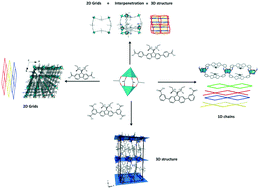A series of chiral metal–organic frameworks based on fluorene di- and tetra-carboxylates: syntheses, crystal structures and luminescence properties†
Abstract
A series of optically pure carboxylate ligands based on a fluorene backbone were synthesized and used for the elaboration of four chiral metal–organic frameworks (6, 7, 8, and 9) containing Cu-based paddle-wheels. The positions and numbers of coordinating carboxylate functions on the ligand core govern the resulting MOF topologies, leading to a 1D framework (8), 2D grids with (7) or without interpenetration (6), and a 3D (9) framework and showing calculated porosities ranging from 8 to 47% of the unit-cell volumes. Ligands as well as corresponding MOFs possess luminescence properties with blue emission. The most porous MOF (9), made of a tetracarboxylate ligand, exhibits a BET apparent surface area of 467 m2 g−1 and methane and carbon dioxide storage capacities of 26.5 cm3 g−1 and 129 cm3 g−1, respectively, at 303 K and 30 bar.

- This article is part of the themed collection: Crystalline Materials for Environmental Remediation


 Please wait while we load your content...
Please wait while we load your content...